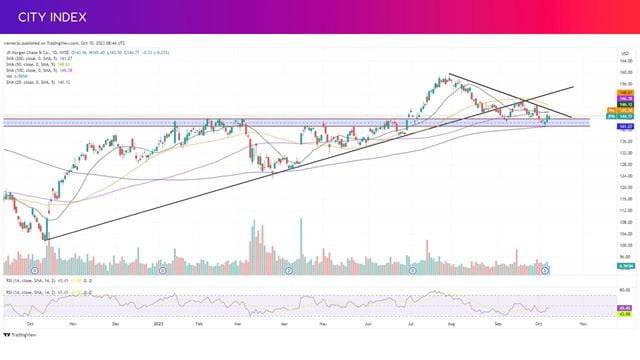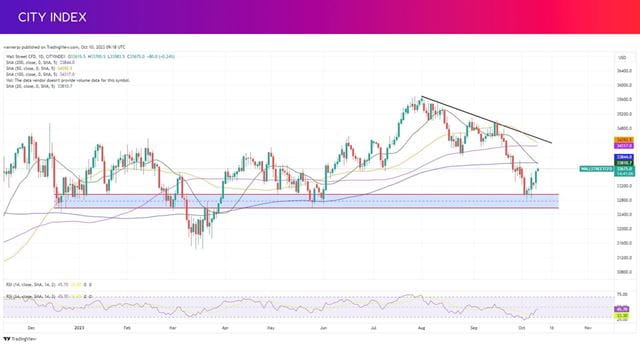
Key takeaways
- JPMorgan is the only major bank in positive territory this year and it could keep outperforming
- Forecast to report fastest earnings growth out of the six major US banks this season
- Benefiting from higher interest rates, but this is also weighing on economic outlook
- Expect more cautious commentary on consumer health and the economy
- Basel III rules and integration of First Republic assets likely topics on the conference call
- May see some green shoots in investment banking
- Likely to stay on course in 2023, but 2024 estimates across the banking industry could be at risk
JPMorgan Q3 earnings date and time
JPMorgan will release third-quarter earnings before markets open on Friday October 13. The results will be released at 0700 EDT and a conference call will be held at 0830 EDT.
Wells Fargo and Citigroup will also be reporting results on the same day as JPMorgan, while Bank of America, Goldman Sachs and Morgan Stanley will follow next week. You can read our broader analysis and find out what to expect from JPMorgan’s rivals in our US Banks Q3 Earnings Preview.
JPMorgan Q3 earnings consensus
JPMorgan is forecast to report a 19.2% year-on-year rise in managed revenue to $39.92 billion and adjusted EPS is seen rising 24.8% to $3.89.
JPMorgan Q3 earnings preview
JPMorgan has outperformed its smaller banking rivals this year and this trend should continue this earnings season.
The anticipated jump at both the top-and-bottom lines is expected to be driven by a 27.5% jump in net interest income in the third quarter to $22.34 billion, with its net interest margin seen improving to 2.63% compared to just 2.09% the year before thanks to higher rates.
JPMorgan is aiming for $87 billion of net interest income over the full year and that looks achievable. The other key guidance is for expenses, which it has said should total around $84.5 billion over the full year.
Investment banking will remain soft, although Wall Street is hopeful that we may see some green shoots. M&A volumes and IPOs both picked-up in the third quarter, although activity still remains below what we saw last year. Trading will also remain tough given the uncertainty weighing on financial markets.
We are not expecting too many surprises when it comes to the results, so the onus will be on the outlook and the conference call, when we expect management to be questioned about hot topics such as consumer health, the economic outlook and the integration of assets bought from First Republic.
CEO Jamie Dimon can grab a lot of headlines when it comes to shaping the economic landscape. He has already suggested that markets and economists are far too optimistic that the Fed is almost done hiking and that rates are approaching their peak, having floated the idea that they could climb as high as 7%! That is a stark warning considering markets are busy debating about whether there is just one more hike on the cards and that rates will peak at 5.50%-5.75%.
The US economy remains resilient, but the outlook is bleaker. Household budgets are starting to feel the strain and the labour market has softened even if job growth remains strong. We believe Dimon and the team will be increasingly cautious on their view on the economy given the lag effect of tightening monetary policy, an anticipated slowdown in consumer spending and economic growth, as well as rising geopolitical risks.
JPMorgan is forecast to book $2.42 billion of loan loss provisions in the third quarter as the entire industry keeps putting more money aside to reflect a more cautious view on the economic outlook and ensure they have enough cash on hand in case more customers start defaulting on their loans. Banks have now been squirreling money away for almost two years. Analysts believe JPMorgan’s provisions may have peaked in the second quarter, but are convinced that provisions will keep building.
With that in mind, the other major discussion point during the conference call could be on Basel III, which are new rules that are being proposed to require banks to hold more capital on their balance sheets. This is specifically targeting the largest banks. A final decision isn’t expected until the second half of 2025 at the earliest and regulators have said they will phase the new requirements in over three years, providing ample runway for banks to adjust. Still, banks may move earlier to ensure they are ready for the overhaul and the changes could be big for the entire industry. Dimon has already warned that the new rules would curtail lending, make loans more expensive for consumers and force banks to expand into less regulated activities. The CEO has admitted that they could make bank stocks un-investable and put them at a disadvantage to international rivals, claiming JPMorgan could be forced to hold up to 30% more capital than a European bank.
A quick recap on First Republic. Having led industry-wide efforts to stabilize the banking system in wake of the crisis that erupted back in March, JPMorgan struck a deal to buy the majority of First Republic’s assets after the regional bank ran into trouble. That saw the largest bank in the US get even bigger as JPMorgan swept-up over $90 billion in deposits, grew its loan book by over $170 billion and added some $30 billion of securities to its balance sheet. At the time, JPMorgan said the deal would boost annual net income by around $500 million each year and be “modestly” accretive to EPS, although it will book around $2 billion in restructuring costs this year and next. The acquisition has also led to exceptional gains for JPMorgan’s bottom-line.
Ultimately, the expansion achieved through the First Republic deal means JPMorgan has been given greater firepower and more deposits to capitalize on the rise in interest rates. Higher interest rates are providing a tailwind for JPMorgan, although the boost is subsiding as comparatives get tougher following 18-month of rate hikes by the Federal Reserve. Plus, JPMorgan has already warned it expects the brakes to come down on net interest income growth going forward because there will be more competition for deposits.
We believe JPMorgan and other US banks will remain on course for the remainder of 2023 but that far more challenging conditions are on the way. They may take several quarters to play out, pushing the pressure onto the outlook for 2024. The level of uncertainty is high, which places earnings estimates for next year at risk. Still, as the largest bank that is already shining among rivals as clouds gather over the horizon, JPMorgan could remain an outperformer.
Where next for JPM stock?
JPMorgan is the only major US bank that is in positive territory in 2023, having risen over 7% since the start of the year whilst many of its rivals have suffered sharp declines. Its financial outperformance the reason for the divergence, plus the fact many of its competitors have company-specific problems weighing on their share prices, such as Citigroup’s restructuring or Wells Fargo’s regulatory limitations.
That would suggest that the bar is higher for JPMorgan ahead of the results relative to other major banks, but JPMorgan’s blended-forward price-to-earnings ratio sits in-line with the industry average and below its five-year historic average.
Let’s jump into the chart. We can see JPMorgan shares hit their lowest level in three months earlier this month as it continues to set new lower-lows. Having rebounded, investors will hope that the stock can find support around $144, marking the ceiling that held throughout the first half of the year. However, the recent-low suggests it could sink to as low as the 200-day moving average, which currently sits at $141 and has remained a reliable floor over the past year, before rebounding. A close below $142 would set a new lower-low and lead to the pullback continuing.
On the upside, the initial goal is to break above $146, where the 20-day and 100-day moving averages have converged. From there, it can challenge the falling trendline that has been in play since shares peaked in July. If it can break above here, then it can look to set a new higher-high by closing above $148.60, in-line with the 50-day moving average.

Dow Jones analysis: Where next?
Updates from JPMorgan, as the largest bank in the US and at the heart of the country’s economy, can be influential on the broader stock market. With that in mind, let’s dive into the Dow Jones Industrial Average (US 30), where JPMorgan carries a weighting of over 2.8%.
The Wall Street CFD has been rebounding since sinking to four-month lows a week ago. The immediate job is to move above 33,700 in order to set a new higher-high and provide some hope that it has reversed course. It will then need to clear 33,800, where the 20-day and 200-day moving averages have converged. A move back above 34,000 is then on the cards.
Investors will hope the recent low of 32,900 will hold as a new floor, although there remains a risk of slipping below 32,600, representing the floors we saw in December 2022 and May 2023, if it comes under renewed pressure.

How to trade JPM stock
You can trade JPMorgan shares and indices with City Index in just four easy steps:
- Open a City Index account, or log-in if you’re already a customer.
- Search for the stock or index you want in our award-winning platform
- Choose your position and size, and your stop and limit levels
- Place the trade
Or you can practice trading risk-free by signing up for our Demo Trading Account.
Take advantage of extended hours trading
The major US banks will release earnings before US markets open and most traders must wait until they open before being able to trade. But you can get ahead of the game by taking a position in premarket hours by taking advantage of our service that allows you to trade JPMorgan, Bank of America and Wells Fargo using our extended hours offering.
While trading before and after hours creates opportunities for traders, it also creates risk, particularly due to the lower liquidity levels. Find out more about Extended Hours Trading.









